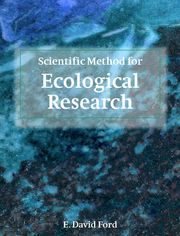Book contents
- Frontmatter
- Contents
- Preface
- Acknowledgements
- 1 Component processes of ecological research
- Introduction to Section I: Developing an analytical framework
- 2 Five processes of research planning
- 3 Conceptual and propositional analysis for defining research problems
- 4 Development of a research plan
- 5 How theories develop and how to use them
- 6 The art of measurement and experiment
- 7 Methods of reasoning in research
- 8 Assessment of postulates
- 9 Individual philosophies and their methods
- Introduction to Section II: Making a synthesis for scientific inference
- Introduction to Section III: Working in the research community
- Introduction to Section IV: Defining a methodology for ecological research
- Appendix: Suggestions for instructors
- References
- Glossary
- Author index
- Subject index
7 - Methods of reasoning in research
Published online by Cambridge University Press: 08 January 2010
- Frontmatter
- Contents
- Preface
- Acknowledgements
- 1 Component processes of ecological research
- Introduction to Section I: Developing an analytical framework
- 2 Five processes of research planning
- 3 Conceptual and propositional analysis for defining research problems
- 4 Development of a research plan
- 5 How theories develop and how to use them
- 6 The art of measurement and experiment
- 7 Methods of reasoning in research
- 8 Assessment of postulates
- 9 Individual philosophies and their methods
- Introduction to Section II: Making a synthesis for scientific inference
- Introduction to Section III: Working in the research community
- Introduction to Section IV: Defining a methodology for ecological research
- Appendix: Suggestions for instructors
- References
- Glossary
- Author index
- Subject index
Summary
Summary
There is no single method of reasoning that scientists can, or do, follow. We reason in two general ways: deductively, when we use the logic of a theory to make a deduction that we then investigate. If we find the deduction correct then we add additional evidence to the theory – inductively, to extend a theory to explain more, where we consider an idea that applies in one situation will also apply in another.
Deduction follows the rules of propositional logic. In research we can use those rules with axioms and postulates to make predictions that we test. Four rules are particularly valuable:
A conjunction is true if, and only if, all of a series of linked propositions are true.
A disjunction is true if any of a series of linked propositions is true.
Some deductions require that concepts be equivalent, and that must be established by research.
The implication statement has the form, “if p, then q” and sequences of such statements are used to establish chains of scientific reasoning.
While the rules of propositional logic are the base of much scientific reasoning, their use is constrained in ecology by the probabilistic nature of many concepts and the problems of investigating systems with multiple causality.
Much reasoning that ecological scientists use to construct theories is inductive. We argue “If such an event/process/condition (A) occurs, then we will observe a particular result (B).” We investigate to see whether B actually occurs, and if it does then we may conclude that A is true. However, B may not be the result of A but of some other factors overlooked in the investigation.
- Type
- Chapter
- Information
- Scientific Method for Ecological Research , pp. 169 - 202Publisher: Cambridge University PressPrint publication year: 2000



